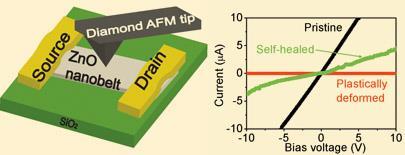New research suggests a simple way to diagnose and repair damage to nanodevices using electric current
Studies on zinc oxide nanobelts hint at a simple method for diagnosing and repairing structural faults in nanodevices. Damaged nanobelts show a surprising ability to ’self-heal’ when an electric current is applied, the researchers report.
Any device, during its lifetime, will inevitably endure some mechanical damage. If the damage can be detected, it may be possible to repair it, or if not the device will probably be thrown away. In the nano-realm, however, monitoring for damage has proved particularly tricky. But Xiaodong Li at the University of South Carolina in Columbia, US and colleagues may have found a solution.
They focused on zinc oxide nanobelts - flat structures that can carry an electric current - because they have a potentially wide range of applications and have been used in creating piezoelectric devices and nanogenerators. To understand how the structures responded to structural damage they dented them with the tip of an atomic force microscope, observing dramatic drops in electrical conductivity as a result. This initial observation is, in itself, significant, since it suggests that damage to device components could be diagnosed by monitoring of an electrical signal.
What happened next, however, was even more intriguing. After an electric current was applied, the nanobelts regained much of their former function - they ’self-healed’ - with healing time depending on the force applied. ’You may say this nanodevice is damaged and throw it away, but after you give the current for a couple of minutes you may fully recover this nanodevice,’ says Li. He explains that local heating of the material when the electric current is applied helps to anneal dislocations in the materials.

The self-healing process is ’rather unexpected’, according to Duncan Gregory, a nanomaterials expert at the University of Glasgow, UK. ’The mechanisms for these processes are not yet known and there is plenty of scope for further investigations of the origins of these effects and the thermodynamics involved,’ he says.
There’s a further implication of the team’s findings though - that by making precise indents in materials like nanobelts, it could be possible to tune their electrical properties. ’A lot of people in industry ask me, "Well, if I have a nanowire, can I tune or modify its electrical signal?",’ says Li. ’So here is a simple methodology.’ His team is already attempting to extend its work into other materials in the hope that it will lead to new guidelines for nanodevice design and manufacture.
Hayley Birch
References
et al, Nano Letters, 2010, DOI: 10.1021/nl103637k






No comments yet